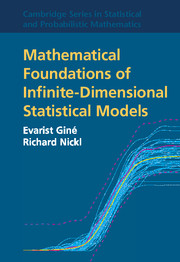Book contents
Preface
Published online by Cambridge University Press: 05 December 2015
Summary
The classical theory of statistics was developed for parametric models with finite-dimensional parameter spaces, building on fundamental ideas of C. F. Gauss, R. A. Fisher and L. Le Cam, among others. It has been successful in providing modern science with a paradigm for making statistical inferences, in particular, in the ‘frequentist large sample size’ scenario. A comprehensive account of the mathematical foundations of this classical theory is given in the monograph by A. van der Vaart, Asymptotic Statistics (Cambridge University Press, 1998).
The last three decades have seen the development of statistical models that are infinite (or ‘high’) dimensional. The principal target of statistical inference in these models is a function or an infinite vector f that itself is not modelled further parametrically. Hence, these models are often called, in some abuse of terminology, nonparametric models, although f itself clearly also is a parameter. In view of modern computational techniques, such models are tractable and in fact attractive in statistical practice. Moreover, a mathematical theory of such nonparametric models has emerged, originally driven by the Russian school in the early 1980s and since then followed by a phase of very high international activity.
This book is an attempt to describe some elements of the mathematical theory of statistical inference in such nonparametric, or infinite-dimensional, models. We will first establish the main probabilistic foundations: the theory of Gaussian and empirical processes, with an emphasis on the ‘nonasymptotic concentration of measure’ perspective on these areas, including the pathbreaking work by M. Talagrand and M. Ledoux on concentration inequalities for product measures. Moreover, since a thorough understanding of infinite-dimensional models requires a solid background in functional analysis and approximation theory, some of the most relevant results from these areas, particularly the theory of wavelets and of Besov spaces, will be developed from first principles in this book.
After these foundations have been laid, we turn to the statistical core of the book. Comparing nonparametric models in a very informal way with classical parametric models, one may think of them as models in which the number of parameters that one estimates from the observations is growing proportionally to sample size n and has to be carefully selected by the statistician, ideally in a data-driven way.
Information
- Type
- Chapter
- Information
- Publisher: Cambridge University PressPrint publication year: 2015
